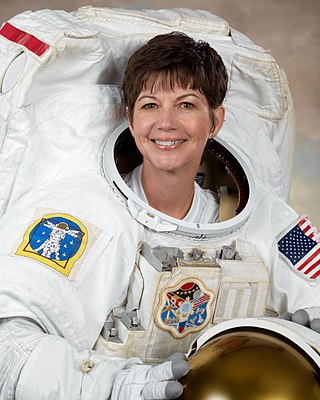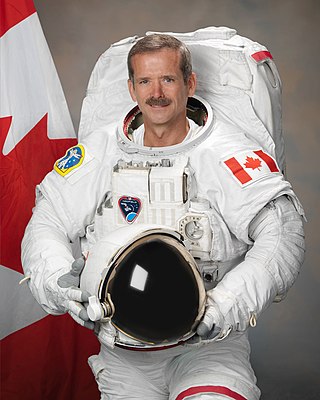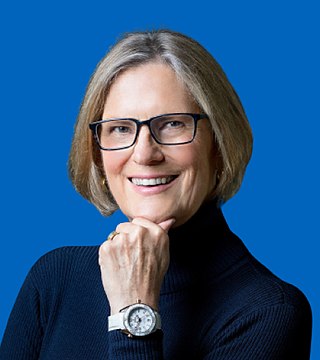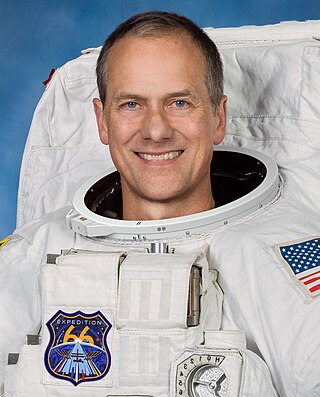Related Research Articles

Catherine Grace "Cady" Coleman is an American chemist, engineer, former United States Air Force colonel, and retired NASA astronaut. She is a veteran of two Space Shuttle missions, and departed the International Space Station on May 23, 2011, as a crew member of Expedition 27 after logging 159 days in space.

The International Space Station (ISS) is the largest space station to have ever been built. The station resides in low Earth orbit and has a primary purpose of performing microgravity and space environment experiments. As implied by its name, the International Space Station is a collaboration of five space agencies and other contractors. These agencies are: NASA, Roscosmos (Russia), JAXA (Japan), ESA (Europe), and CSA (Canada).

Chris Austin Hadfield is a Canadian retired astronaut, engineer, fighter pilot, musician, and writer. The first Canadian to perform extravehicular activity in outer space, he has flown two Space Shuttle missions and also served as commander of the International Space Station (ISS). Prior to his career as an astronaut, he served in the Canadian Armed Forces for 25 years as an Air Command fighter pilot.

Sally Kristen Ride was an American astronaut and physicist. Born in Los Angeles, she joined NASA in 1978, and in 1983 became the first American woman and the third woman to fly in space, after cosmonauts Valentina Tereshkova in 1963 and Svetlana Savitskaya in 1982. She was the youngest American astronaut to have flown in space, having done so at the age of 32.

The Canadian Space Agency is the national space agency of Canada, established in 1990 by the Canadian Space Agency Act.

Fred Wallace Haise Jr. is an American former NASA astronaut, engineer, fighter pilot with the U.S. Marine Corps and U.S. Air Force, and a test pilot. He is one of 24 people to have flown to the Moon, having flown as Lunar Module pilot on Apollo 13. He was slated to become the 6th person to walk on the Moon, but the Apollo 13 landing mission was aborted en route.

Kathryn Dwyer Sullivan is an American geologist, oceanographer, and former NASA astronaut and US Navy officer. She was a crew member on three Space Shuttle missions.

Dafydd "David" Rhys Williams is a Canadian physician, public speaker, author and retired CSA astronaut. Williams was a mission specialist on two Space Shuttle missions. His first spaceflight, STS-90 in 1998, was a 16-day mission aboard Space Shuttle Columbia dedicated to neuroscience research. His second flight, STS-118 in August 2007, was flown by Space Shuttle Endeavour to the International Space Station. During that mission he performed three spacewalks, becoming the third Canadian to perform a spacewalk and setting a Canadian record for total number of spacewalks. These spacewalks combined for a total duration of 17 hours and 47 minutes.

STS-100 was a Space Shuttle mission to the International Space Station (ISS) flown by Space Shuttle Endeavour. STS-100 launch on 19 April 2001, and installed the ISS Canadarm2 robotic arm.

Michael James Massimino is an American professor of mechanical engineering at Columbia University and a former NASA astronaut. He is the senior advisor of space programs at the Intrepid Sea, Air & Space Museum.

Thomas Henry Marshburn is an American physician and a former NASA astronaut. He is a veteran of three spaceflights to the International Space Station and holds the record for the oldest person to perform a spacewalk at 61 years old.

The National Aeronautics and Space Administration is an independent agency of the U.S. federal government responsible for the civil space program, aeronautics research, and space research. Established in 1958, NASA succeeded the National Advisory Committee for Aeronautics (NACA) to give the U.S. space development effort a distinctly civilian orientation, emphasizing peaceful applications in space science. NASA has since led most American space exploration, including Project Mercury, Project Gemini, the 1968–1972 Apollo Moon landing missions, the Skylab space station, and the Space Shuttle. NASA currently supports the International Space Station and oversees the development of the Orion spacecraft and the Space Launch System for the crewed lunar Artemis program, the Commercial Crew spacecraft, and the planned Lunar Gateway space station.

NASA Astronaut Group 14 was a group of 24 astronauts announced by NASA on 31 March 1992. The group's name derived from The Muppet Show skit "Pigs in Space" and from the group's sponsorship of a pot-bellied pig at the Houston Zoo.

Expedition 35 was the 35th long-duration mission to the International Space Station (ISS). The expedition started 13 March 2013, and marked the first time a Canadian astronaut – Colonel Chris Hadfield – was in command of the station. Expedition 35 was also only the second time an ISS crew is led by neither a NASA astronaut, nor a Roscosmos cosmonaut, after Expedition 21 in 2009, when ESA astronaut Frank De Winne was in command. The expedition lasted two months.

Women have flown and worked in outer space since almost the beginning of human spaceflight. A considerable number of women from a range of countries have worked in space, though overall women are still significantly less often chosen to go to space than men, and by June, 2020 constitute only 12% of all astronauts who have been to space. Yet, the proportion of women among space travelers is increasing substantially over time.

Music in space is music played in or broadcast from a spacecraft in outer space. The first ever song that was performed in space was a Ukrainian song “Watching the sky...”(“Дивлюсь я на небо”) sang on 12 August 1962 by Pavlo Popovych, cosmonaut from Ukraine at a special request of Serhiy Korolyov, Soviet rocket engineer and spacecraft designer from Ukraine. According to the Smithsonian Institution, the first musical instruments played in outer space were an 8-note Hohner "Little Lady" harmonica and a handful of small bells carried by American astronauts Wally Schirra and Thomas P. Stafford aboard Gemini 6A. Upon achieving a space rendezvous in Earth orbit with their sister ship Gemini 7 in December 1965, Schirra and Stafford played a rendition of "Jingle Bells" over the radio after jokingly claiming to have seen an unidentified flying object piloted by Santa Claus. The instruments had been smuggled on-board without NASA's knowledge, leading Mission Control director Elliot See to exclaim "You're too much" to Schirra after the song. The harmonica was donated to the Smithsonian by Schirra in 1967, with his note that it "...plays quite well".

For All Mankind is an American science fiction drama television series created by Ronald D. Moore, Matt Wolpert, and Ben Nedivi and produced for Apple TV+. The series dramatizes an alternate history depicting "what would have happened if the global space race had never ended" after the Soviet Union succeeds in the first crewed Moon landing ahead of the United States. The title is inspired by the lunar plaque left on the Moon by the crew of Apollo 11, which reads, in part, "We Came in Peace for All Mankind".

Joshua Kutryk is a Canadian astronaut, fighter piolet and engineer. He was selected by the Canadian Space Agency (CSA) one of the two members of the 2017 CSA Group alongside Jenni Sidey.
References
- ↑ "REACH: A Podcast for Kids ISS Downlink | Science Mission Directorate". science.nasa.gov. Archived from the original on May 19, 2023. Retrieved May 19, 2023.
- ↑ "Podcast Spotlight: REACH: A Space Podcast for Kids". Discover Pods. May 25, 2021. Archived from the original on May 19, 2023. Retrieved May 19, 2023.
- ↑ "Reach for Space". Time for Kids. September 7, 2022. Archived from the original on May 19, 2023. Retrieved May 19, 2023.
- ↑ Shaw, Nichole (September 3, 2021). "Space podcast for kids connects with NASA astronauts". Chicago Sun-Times. Archived from the original on May 19, 2023. Retrieved May 19, 2023.
- ↑ Rogers, Anne Bensfield and Pamela. "Kidcasts: Trendsetters in 2021". School Library Journal. Archived from the original on May 19, 2023. Retrieved May 19, 2023.
- ↑ "REACH: A Space Podcast for Kids". August 25, 2021. Archived from the original on May 19, 2023. Retrieved May 13, 2023.
- ↑ "REACH: A Space Podcast for Kids featuring Fleming Medallist Chris Hadfield". Royal Canadian Institute for Science. March 8, 2022. Archived from the original on May 19, 2023. Retrieved May 19, 2023.
- ↑ Champion, Herb Garbutt Milton Canadian (February 22, 2022). "Milton retired astronaut Chris Hadfield to appear on children's space podcast". Inside Halton. Archived from the original on May 19, 2023. Retrieved May 19, 2023.
- ↑ Staff, Chicago Parent (July 29, 2020). "New Space Podcast Launches for Kids". Chicago Parent. Archived from the original on May 19, 2023. Retrieved May 19, 2023.
- ↑ "New and notable: August edition". Archived from the original on May 19, 2023. Retrieved May 13, 2023.